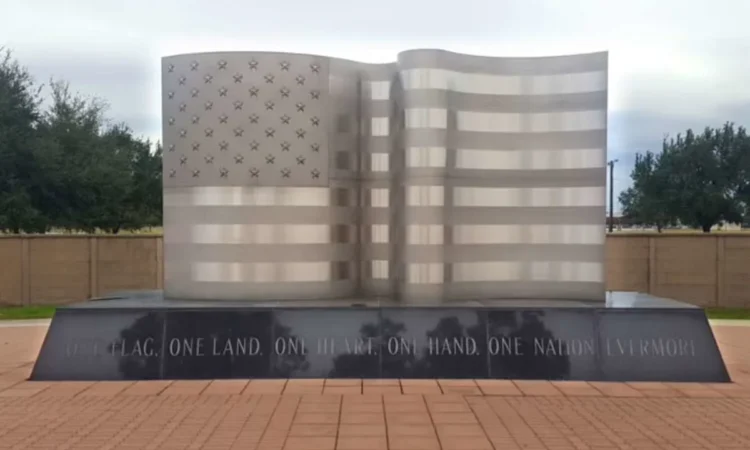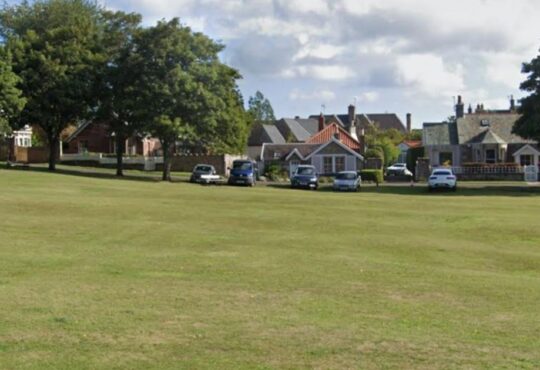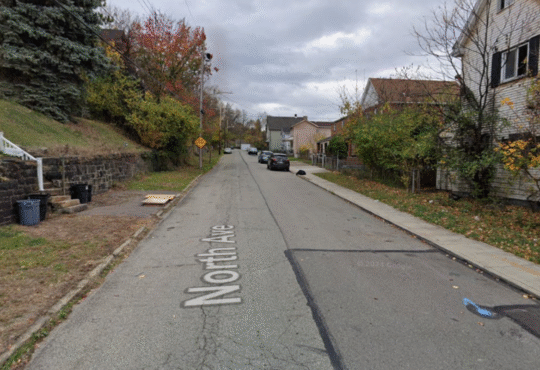
My sister purchased a veteran’s brick for our dad. I read (the Kelly AFB memorial) was going to be in a new location early in 2025. Can you tell me where that is? If not, did you find out any new information?
– Hortensia Villarreal
You might have read a previous column on the subject of the Kelly AFB veterans memorial (covered here Oct. 12, 2024) dedicated in 1992 just outside the main gate of the former military installation. The monument park included a rippling metal American flag sculpture set within a plaza built of commemorative bricks.
The bricks were inscribed with the names of individuals, families and organizations that were part of Kelly’s history, dating back to World War I. Other historical markers and sculptures, such as a bust of namesake George E.M. Kelly, an early military pilot who died in a 1911 air crash at Fort Sam Houston, also became part of the memorial.
Kelly was closed in 2001 and redeveloped into Port San Antonio, a trade gateway and technology campus where some reminders of the longtime air base have been preserved.
READ MORE: Kelly Veterans Monument currently in storage; Port San Antonio designing new home for it
The personalized bricks – removed during ongoing redevelopment – are among them, with work on a suitable historic site still proceeding.

Inscribed bricks, part of fundraising efforts for the Kelly Veterans Monument, are stacked and transported to secure storage until the monument can be reassembled early next year at an accessible site of historic interest. (Port San Antonio)
“The design for the planned relocation of the Kelly artifacts to the open space by the Bungalow Colony continues and has taken a bit longer than expected,” said Paco Felici, Port San Antonio’s chief communications officer.
The first of the wood-frame houses or bungalows in what is now the Kelly Historic District were completed in 1920, according to “The Bungalow Colony of Kelly Air Force Base,” by Robert S. Browning III, a former Kelly historian. What was left of the hastily built World War I-era quarters was inadequate. In 1919, the flying field’s commander Col. Henry C. Pratt said, “I don’t believe that accommodations are as bad at any field in the country,” and his successor successfully requested funds for their replacements.
Salvaged material from “dismantled wartime buildings” was used to construct the houses. “By the end of the decade,” Browning says, “the 10 homes originally planned … had grown to a sizable community of 12 individual family units,” along with bachelor officers’ quarters and a headquarters building.
S.A. HISTORY: Historic wooden structure at Port San Antonio could be early flight control tower for Kelly AFB
Before a 1980s renovation, there was talk of tearing down the “decaying” bungalow colony and replacing it with new homes. “In the end, though, their importance as part of the heritage of Kelly won out,” Browning says. “The tree-shaded streets and white-sided homes are a viable link to the pioneer airmen (of) the early days of military aviation.”
Another restoration of these former officers’ residences is underway, in partnership with the city’s Office of Historic Preservation.

As shown in this 1924 photo, the Bungalow Colony was a small group of officers’ quarters at Kelly Field, founded during World War I and closed in 2001 as Kelly AFB. The houses were built from salvaged lumber and are now part of the Kelly Historic District at Port San Antonio. (U.S. Air Force)
The “Pretty Bungalow Colony at Kelly Field,” as it was announced in the San Antonio Light, Jan. 1, 1922, was composed of officers’ residences in the popular style of the time – one-story houses with a low-pitched roof and a veranda or porch.
The news story referred to the first five such structures to be built, along with recreational facilities and outbuildings such as servants’ quarters, garages and a central steam-heating plant. More houses would be constructed through 1927; they are “among the earliest remaining family officers’ quarters still standing on any Air Force or air depot base in the continental United States,” says a description from the Historic American Buildings Survey, a National Park Service study.

The San Antonio Light, Jan. 1, 1922, describes the first five houses in the “bungalow colony” at Kelly Field (later AFB) as “attractive,” cost-effective and “homelike.” They housed the commander of the Air Service Depot and other officers, sharing a central heating plant but “built far enough apart to set them off to an advantage.” (San Antonio Light)
Of additional significance, this compound “was different from other neighborhoods for service members because it was not constructed according to quartermaster-generated, standardized plans,” said Lauren Sage, spokeswoman for the city preservation office.
S.A. HISTORY: Readers ask for help with ‘orphan’ pavers in downtown San Antonio
“Instead, the builders of the bungalow colony made minor design changes between individual homes in rafter ends, porch supports, brackets, rakes and siding details without detracting from the visual unity of the neighborhood.
“Most other groups of officers’ quarters required rigid duplication. In the Bungalow Colony, however, additions blended easily into the core building, just as the addition of other bungalows through time blended into the colony as a whole,” she said.
The preservation office has been working on their restoration with Port San Antonio for a few years, Felici said. “Their team has used the large front bungalows as part of programs to train tradespeople to apply their craft to older homes.”
Some of the salvaged materials have come to light during the deconstruction phase of the restoration project.
S.A. HISTORY: Daughters of the Union seek to preserve marker as mystery surrounds another
“There are stamps in the rafters and walls of many of these buildings that tell us where the lumber originated,” Sage said, “including some from Hagerstown, Md., where airplane parts were packed and shipped to Kelly Field.”
The former residences under restoration are “a learning lab for students and apprentices enrolled in OHP’s Living Heritage Trades Academy,” she said. Participants in its short-term programs “receive hands-on training in the traditional (building) trades, including wood window repair, siding and skirting repair and more.”

Participants in the city’s Living Heritage Trades Academy – a program of the Office of Historic Preservation – get hands-on training in wood window repair at Port San Antonio, where a restoration of 100-year-old former Kelly AFB officers’ quarters is underway. ( Office of Historic Preservation)
A back building at the location “has been used for storage of lumber, fixtures and other materials taken from older properties,” Felici said, to be repurposed into upcoming projects.
The bungalow project continues, “with plans to tackle a couple more in the year ahead.”
S.A. HISTORY: Mystery man in family photo might be former President Roosevelt

The metal flag sculpture from the Kelly Veterans Monument is removed for storage in early 2020. This and other artifacts from the former monument park along General Hudnell Drive were put in storage to make room for redevelopment on the Port San Antonio campus. The port is readying a new home for the sculpture. (Port San Antonio)
The personalized bricks and other artifacts from the monument park eventually will be replaced in an open space near the restored Bungalow Colony. At the southeast corner of General Hudnell and General McMullen drives, the area will afford ample parking and pedestrian access for those who wish to see the memorial items.
“We should start seeing placement of the flag and other elements early in the new year,” Felici said. “Meanwhile, they remain safely stored.”
historycolumn@yahoo.com | X (formerly Twitter): @sahistorycolumn | Facebook: SanAntoniohistorycolumn
This article originally published at Former Kelly memorial to be replaced near restored historic Bungalow Colony.






